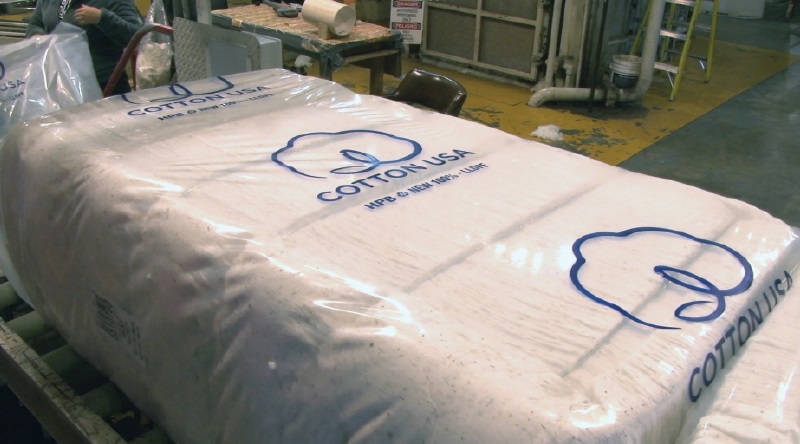At Beltwide, Researchers Question Whether One Size Fits All
At this year’s Beltwide Cotton Conferences in January, an intriguing theme appeared during the presentations on weaving and spinning technologies: a re-examination of the sizing and desizing process, and the feasibility of potential alternative approaches.
A presentation and poster explored alternatives to sizing and desizing fabrics, and reached the conclusion that with further study, modern weaving could adopt size-free practices.
The following section excerpts these studies and findings, which were conducted by Kumar V. Singh, Miami University, Oxford, Ohio, U.S.; Paul S. Sawhney and Brian Condon, Southern Regional Research Center (SRRC), New Orleans, Louisiana, U.S.; and Jayaram Subramanian and Su-Seng Pang, Louisiana State University, Baton Rouge, Louisiana, U.S.
The Problem
Cotton fabrics of single yarns almost always are woven by using sized warps. Sizing improves tensile strength and abrasion resistance of cotton yarns, which consequently enables efficient weaving. However, warp sizing and the subsequent fabric desizing are costly, complex, and environment-sensitive. The textile industry wants to reduce or eliminate warp sizing.
Although the cotton fiber quality, yarn spinning technologies, yarn quality, weaving machines and technologies, textile production methodologies, and workforce have considerably advanced in the past few decades, size-free (size-less) weaving of cotton fabrics on a modern high-speed weaving machine had not been explored until 2005, when the Agricultural Research Service (ARS) of the U.S. Department of Agriculture (USDA) first investigated the feasibility of such weaving. In fact, size-free weaving of cotton yarns/fabrics even on conventional weaving machines has never been successfully investigated. In the 1970’s, Gandhi, et. al., had investigated weaving of a cotton fabric with a size-less warp on a conventional fly-shuttle loom and reported that efficient weaving of a cotton warp yarn without sizing was almost impossible. However, they claimed that weaving of singed cotton warp yarns without sizing was possible. It may be noted that yarn singing is a process in which the yarn’s projecting fibers are burnt away, which obviously changes the yarn’s surface characteristics, as the sizing process does.
In 2003, scientists at SRRC conducted a size-free weaving trial on a conventional fly-shuttle loom to explore the feasibility of size-free weaving, by using the best men and women, materials and methods available. In this trial, a total of around 100 meters of a 100% cotton twill fabric of a relatively less-dense construction were produced with no warp yarn breakage or failure, for the first time ever. Although the warp yarn, as expected, received extensive abrasion during weaving – especially in the reed-sweep zone – it absolutely did not cause any inter-fiber or inter-yarn entanglements to cause any mechanical and/or yarn failures. The fabric appearance after plain scouring and washing seemed to be marginally acceptable. Thus, the size-free weaving trial on a fly-shuttle weaving machine had, for the first time, demonstrated that size-less weaving indeed was at least “mechanically” feasible for certain types of cotton yarns and fabrics.
A Modern Approach
Since the fly-shuttle looms are almost obsolete in the U.S. textile industry, the exploratory research on size-free weaving had to be redirected to include a modern high-speed weaving machine. Accordingly, in 2005, a size-free weaving trial was conducted on a modern flexible-rapier machine, which was operated under almost mill-like conditions. The best possible materials and methods were used in this trial as well, to produce a 100% cotton twill fabric of light construction. Again, as a pleasant surprise, more than 100 m of cloth were woven without warp sizing and without any yarn breakage or mechanical failure. This certainly is a great encouragement and a significant milestone toward progress in size-free weaving. For the first time ever, the trial demonstrated the mechanical feasibility of size-less weaving on a modern high-
However, the fabric quality was not satisfactory, mainly because of the numerous tiny fuzzy balls that most likely were formed by the protruding fibers generated by excessive yarn abrasion, mainly in the reed-sweep zone of the weaving process. Efforts to minimize yarn abrasion and thereby improve fabric quality are underway.
Based on the existing knowledge about the desized and washed fabrics woven with conventionally sized cotton warps, the tensile and tear strengths of the size-less fabrics are comparable – especially considering a possible, slight damage of the latter due to flood waters from Hurricane Katrina, which hit during the study.








